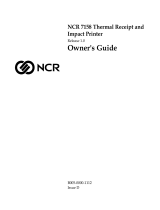
Table of contents
1 Product features ........................................................................................................................................... 1
Identifying user controls ....................................................................................................................................... 2
Identifying rear components ................................................................................................................................. 3
2 Setting up the printer .................................................................................................................................... 4
Choosing a location for the printer ........................................................................................................................ 4
Checking the packing list ....................................................................................................................................... 4
Removing the packing materials ........................................................................................................ 5
Installing new receipt paper .................................................................................................................................. 5
Removing and installing a ribbon cassette ........................................................................................................... 7
Removing a used ribbon cassette ....................................................................................................... 7
Installing a new ribbon cassette ......................................................................................................... 8
Connecting the cables ............................................................................................................................................ 9
Installing the driver ................................................................................................................................................ 9
Testing the printer ............................................................................................................................................... 10
Test procedure ................................................................................................................................... 11
Test printout ...................................................................................................................................... 11
Printer congurations .......................................................................................................................................... 11
Conguring the printer ........................................................................................................................................ 13
Changing diagnostic modes .............................................................................................................. 14
Enabling or disabling data scope mode ............................................................................................ 14
Enabling or disabling receipt test mode ........................................................................................... 15
Enabling or disabling slip test mode ................................................................................................. 16
Enabling and disabling MICR test mode ............................................................................................ 16
Setting the printer emulations and software options ...................................................................... 17
3 Operating the printer ................................................................................................................................... 20
Printing on forms or checks ................................................................................................................................. 20
Front-insertion printing method ....................................................................................................... 20
Drop-in printing method ................................................................................................................... 21
Inserting multipart forms ................................................................................................................. 21
Verifying and validating checks ........................................................................................................................... 22
Inserting a check ............................................................................................................................... 22
Avoiding printer problems ................................................................................................................................... 23
Preventing print head overheating ................................................................................................... 23
Avoiding harsh environments ........................................................................................................... 24
v





















